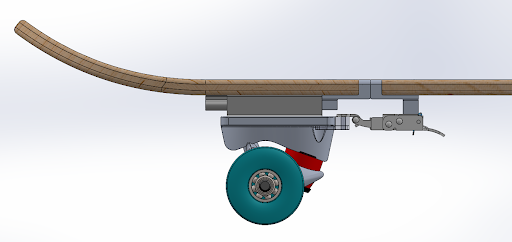Collapsible Skateboard
Problem/design description
Skateboards have been a staple of the “last mile” transportation methods for years. They provide an easy and convenient way to make the 1-5 mile commute effortlessly, and promote environmentally friendly travel.
However, the biggest drawback of using skateboards is the inability to store the oddly-shaped boards once users reach their destination. And unlike bikers, there are no easily accessible racks or storage areas for people to use. This not only provides an inconvenience for the user, but a safety hazard if these boards are improperly or haphazardly stored.
Concept Generation
We wanted to make sure our product was the best in its category, while also making sure we were selecting the best mechanism for our usage, as seen in the Pugh Chart above. For our initial concept, we started with carbon fiber rods and latches on the sides to keep the board together, along with detachable sliders for the trucks. We wanted to keep the center of the board wooden to preserve the flexibility and response our users rely on.
As our design evolved, we continued using the sliding truck mechanism to disconnect our wheels, but the biggest change in our concept generation came from our attachment mechanism. The carbon fiber rods worked, however the uncertain manufacturing tolerances and difficulty fitting the rods precisely into the wood prompted us to explore other connection mechanisms.
Functional Analysis
Our attachment design has 3 main functional components, interconnected and symmetrical on each half of the board. These components are the carriage/guide rail attachment, The L brackets, and the clamping mechanism.
The carriage/guide rail attachments were both bought rather than machined, and these parts are properly toleranced, so their attachment points require no alteration. The L brackets were machined using both a CNC and mill. The male parts are attached at each end of the midsection of the board, and the female parts are each attached at the ends of the board. These must be better toleranced in the future, which can be done by finding a way to minimize machining while manufacture these, so as to reduce human error caused by machining. The clamping mechanism contains a spring loaded latch that helps to not only join the board but also prevent the truck from sliding off, and must also be better toleranced by using the correct materials in the future and redesigning some of the parts in CAD.
Prototyping
Design process
I was in charge of designing and picking catalog parts for all components of the skateboard.
CAD: It was mainly done in Solidworks, I was the main contributor to the iterations of the CAD.
FEA: My teammates and I used Ansys to perform collision simulation to ensure the impact won’t break the assembly. In addition, I used Solidworks to perform static structural analysis on single component to iterate designs/dimensions to obtain the desirable factor of safety.
Material Selection: I utilized CES software and material index derived from our loading condition and design emphasis on strength to find the best material that minimize weight.
Manufacturing: We mainly used CNC and milling for our aluminum brackets and I programmed the CAM file with MasterCam for the L-bracket and manufactured them in machine shops with CNC and mill.













